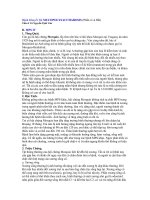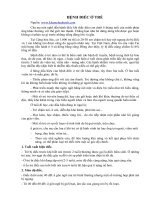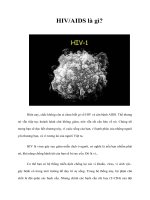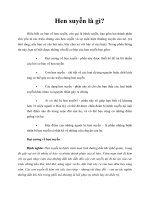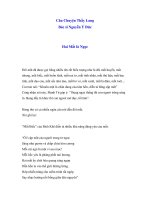Tài liệu Pordeus Imm 94 Final pdf
Bạn đang xem bản rút gọn của tài liệu. Xem và tải ngay bản đầy đủ của tài liệu tại đây (127.97 KB, 9 trang )
ABSTRACT
The immune system is usually seen as a collection
of independent (specific) lymphocyte clones.
Randomly generated and activated at random,
these lymphocytes follow only their individual,
clonal history. Thus, in traditional descriptions,
immunological activity is neither systemic nor
historical and is never “physiological”. However,
recent descriptions show an abundant “auto”-
reactivity in healthy organisms, an evidence of
internal connectivity. The two major sources of
immunogenic contacts, namely, dietary proteins
and products of the autochthonous microbiota fail
to induce progressive “secondary-type” clonal
expansions (or “memory”). Natural IgM may
arise in “antigen-free” organisms as they do in
conventionally raised animals; actually, clonal
receptors of both T and B lymphocytes are formed
in antigen-free intracellular environments and
are not driven by antigen exposure. Early in
ontogenesis natural immunoglobulins are organized
in characteristic patterns of reactivity which
are robustly stable throughout healthy living;
Immunopathology and oligoclonal T cell expansions.
Observations in immunodeficiency, infections, allergy and
autoimmune diseases
*Corresponding author
Dr. Vitor Pordeus
Rua Prof. Antônio Maria Teixeira, 33 apto 203,
Leblon, Rio de Janeiro, Brazil 22430050
these patterns depend on genes known to be
important in immunological activity. Predictable
(not-random) variations on these patterns occur
during infectious and autoimmune diseases,
both in humans and experimental animals,
which are correlated with different clinical states
of these diseases. All this is incompatible
with a random process driven by independent
lymphocytes. In different pathological conditions,
ranging from immunodeficiencies to parasite,
allergic and autoimmune diseases, the organism
develops oligoclonal expansions of T lympho-
cytes. In addition, oligoclonality is associated
with high IgE titers and eosinophilia. We propose,
therefore, that the physiology of the immune
system is conservative and remains stable
throughout healthy living. In several types
of experimental and clinical diseases, this stability
is broken by oligoclonal expansions of T cells.
Specific immune responses, understood as
the progressive expansion of oligoclonal lympho-
cytes, are expressions of immunopathology rather
than immune physiology. A new explanation
of the protective effects of anti-infectious
vaccination is offered.
KEYWORDS: theory, immune system,
conservation, oligoclonality, vaccines
1
Núcleo de Cultura, Ciência e Saúde da Secretaria Municipal de Saúde e Defesa Civil, Rio de Janeiro,
2
Departamento de Farmacologia, CCB, UFSC, Florianópolis, SC,
3
Departamento de Morfologia, ICB,
UFMG, Belo Horizonte, MG,
4
Departamento de Bioquímica e Imunologia, ICB, UFMG,
Belo Horizonte, MG, Brasil
Vitor Pordeus
1,
*
, Gustavo C. Ramos
2
, Claudia R. Carvalho
3
, Archimedes Barbosa De Castro Jr.
4
,
Andre Pires Da Cunha
4
and Nelson M. Vaz
4
Current Trends in
Immunology
Vol. 10, 2009
22 Vitor Pordeus et al.
vaccines and antisera proved to be much harder
than anticipated. Research in Immunology was
diverted to biochemical (immunochemical) trends.
On the one hand, this allowed fundamental
progress to be made, such as unraveling the basic
physicochemical structure of specific antibodies,
their antigen binding sites, variable and constant
regions, etc. On the other hand, the interest was
kept distant from biological problems [4]. The
(“adoptive”) transfer of cell-dependent immunologic
phenomena with living cells was only recognized
in the mid 1940s [10]; the thymus and
T lymphocytes were characterized in the 1960s
[11, 12]; and the role of the MHC in T cell
activation only in the 1980s [13, 14].
In summary, in the first half of the last century,
Immunology developed under a biochemical and
medical orientation. During this period, the notion
of “allergy” as a deviant, pathogenic form of
inflammation was developed, and, especially in
Germany, chronic diseases were understood as
distortions in regenerative processes. This was
quite different and did not include or correspond
to what, from the 1960's on, was understood as
forms of lymphocyte-dependent “autoimmune”
damage [15]. “Cellular Immunology” [16], was
born in the 1950-1960s.
Lymphocytes were
definitely brought to a central position [17, 18].
Two unexpected turns then took place: specific
immunological “tolerance” was described in
studies of allogenic skin grafts [19]; and Jerne
proposed the Natural Selection Theory of
Antibody Formation [20]. Soon thereafter, Burnet
proposed The Clonal Selection Theory (CST) as a
cellular modification of Jerne’s proposal [21, 22].
The CST claimed that in response to their
specific antigens, immunological activity arises
by the expansion of lymphocytes into “clones” -
lymphocyte collections with the same genetic
(nucleic) content, which then expand and
differentiate into antibody-secreting cells. The
theory explained specific immune responses,
immunological memory and, thus, their putative
role in anti-infectious vaccination. In addition,
the CST explained the phenomenon of specific
immunological “tolerance” to alloantigens,
suggesting that it was due to specific clonal
abrogation. As the CST proposed a random origin
for lymphocyte clones, “auto-reactive” clones
INTRODUCTION
A glance through history
It is trite to say that one may not explain
pathologic deviations if we ignore the physiology
of which they are deviations. Current immunology,
neglects the need to define a physiology for the
immune system, its behavior in healthy living
[1-3]. Immunology is historically linked to the
study of diseases: first infections, then allergies
and, from the 1960s, pathogenic autoimmunity.
New experimental developments, however, may
allow us to understand what the immune system
does in healthy living and, based on this
knowledge, trace common mechanisms of
infectious, allergic and autoimmune diseases.
By the end of 19th century, Pasteur and Koch
developed a theoretical framework, known as the
‘Germ Theory’ of infectious diseases [4] and
immunologists devoted themselves to study
vaccines and other immune defenses against
infectious agents. Vaccination and serum therapy
were invented as successful forms of prevention
and treatment of infectious diseases. The
first molecular and cellular components of
immunological activity- namely, specific
antibodies, the Complement-system, macrophages
and phagocytosis- were characterized in the
pursuit to understand how an organism becomes
specifically “immune” to a particular pathogen
and how the “memory” of this event may be
conserved in the organism.
Meanwhile, “natural” or spontaneously formed
antibodies of unknown origin, such as human
isohemagglutinins, were also characterized [5]
and severe hypersensitivity reactions, such as
anaphylaxis [6] and serum sickness [7] were
shown to be triggered by immunological
mechanisms. These findings blurred the exclusive
“anti-infectious” role played by specific immune
mechanisms. The formation of specific antibodies
to plant proteins as well as to allelic variations of
red cells of the same species was demonstrated
[8] and diseases that are presently recognized
as autoimmune, such as Paroxysmal Nocturnal
Hemoglobinuria, were also characterized at that
moment [9].
In the following period, the enthusiasm was
curtailed because inventing effective new
Immunopathology and oligoclonal T cell expansions 23
recently proposed that the immune system
exhibits a conservative physiology [1, 3]. It is
widely accepted that the feeding of a given
antigen is capable of “decreasing” rather than
increasing B and T cell responsiveness to it, a
phenomenon called “oral tolerance” [35, 36].
However, rather than a decrease in immunological
responsiveness, oral tolerance is more correctly
described as a stabilization of lymphocyte
reactivity, that ‘locks’ robust patterns of
antibodies formation in spite repeated parenteral
immunizations with a given immunogen in
adjuvant [37]. The physiological activity of
mucosal lymphocytes is a most prominent aspect
of immunological activity, since the number of
lymphocytes in the small intestine exceeds several
fold the number found in all the other lymphoid
organs together [38]; in addition, hundreds of
grams of dietary proteins are placed in contact
with the human small intestine every day, during
our healthy, physiological daily feeding, and some
of it penetrates the body in immunologically
relevant forms [35, 36]. In addition, the analysis
of the reactivity of ‘natural antibodies’ (natural
serum IgM and IgG), through a modified
technique of immunobloting [39, 40] and also of
T cells, through spectratyping (CDR3 length
analysis) [41], repeatedly showed that patterns of
reactivity of B and T lymphocytes with complex
antigen mixtures are robustly conserved
throughout the healthy living of human beings and
a variety of experimental animals [42]. These
patterns are established early in ontogenesis-
around 2 years-old humans- and remain conserved
throughout healthy living. Similar findings
regarding the stability of T cell repertoires
have been described with spectratyping [43] and
V-beta repertoire analysis by flow cytometry
[44]. In elder humans, more consistently at the
seventh decade, the pattern of reactivity of
immunoglobulins and T cells begin to change and
this coincides with the handicaps associated with
immunossenescence [45].
In short, when tested en bloc, B and T
lymphocytes of healthy organisms display
remarkably stable patterns of reactivity, reflecting
the activity of a robust network of lymphocytes.
Mucosal contacts with immunogens, a daily event
of highly physiological significance, also leads to
stable levels of specific reactivity, rather than a
would necessarily arise and should be “forbidden”
to expand in order to avoid “auto-aggressions”
(autoimmune diseases). Thus, self/nonself
discrimination and pathogenic autoimmunity
became central tenets in the theory. Experimental
models of such autoimmune aggressions were
soon developed [23] and immediately thereafter
clinical counterparts were also described [24]. The
concept of auto-immunity underwent a huge
development in medicine; presently, more than 80
different diseases are described as “autoimmune”
and the idea of pathogenic autoimmunity replaced
the idea of “allergy” [15] as the main mechanism
involved in chronic human diseases.
The idiotypic network: A frustrated systemic
approach
A second wave of developments not directly
related to infections and anti-infectious defense as
the raison d'être of immunological activity,
occurred in the 1970s. Although widely accepted,
the CST has a major flaw: it forbids auto-
reactivity and, in so doing, excludes the
possibility of interclonal connections and also
interactions of these clones with the organism. In
other words, forbidden auto-reactive clones
preclude all kinds of systemic – organism-
centered – approaches to immunological activity.
The Idiotypic Network Theory offered a brand
new understanding to immunological activity in
which auto-reactivity was turned from forbidden
activity into physiological rule [25]. Although
frequently neglected by mainstream immunologists,
especially in United States [26], idiotypes have a
clear relevance in the development of the immune
system [27], of specific memory [28] and of
immunopathology [29]. The network approach
allowed the description of an internal, immanent
source of immunological activity, as a first
approach to a physiology of the system [1, 30].
Lymphocytes are certainly involved in
physiological activities, such as dietary protein
assimilation [31, 32]; pregnancy and lactation
[27]; tissue regeneration [33]; cell turnover and
apoptosis [34] - among many other phenomena.
The conservative physiology of the immune
system
Stemming from immunological phenomena
triggered by mucosal exposures to antigens, we
24 Vitor Pordeus et al.
of IgE hundred-fold higher than normal
(30-200 µg/ml). This increased IgE production
could be avoided by the infusion of normal
syngeneic T CD4+ policlonal lymphocytes, either
CD25+ or CD25 These data suggest that in
normal individuals, IgE production is controlled
by the policlonal activity of CD4+ T cells [51].
Omenn’s syndrome may also be seen as a
natural counterpart of a series of experiments
investigating the consequences of thymectomy of
3-day old mice [52, 53]. Thymectomy at this early
stage is pathogenic because it allows the
introduction of a sub-optimal variety of T in
lymphopenic organisms, and these cells undergo
extensive expansion. The variety of T cells
emerging from the thymus in the first three days
extra-uterine of mouse life is insufficient to
establish normal T cell diversity; when these
oligoclonal lymphocytes expand, they become
pathogenic [52, 53]. This expansion is independent
of the recognition of external antigens, but
depends on the recognition of MHC-linked
autologous peptides [54]; it may be as high as
thirty-fold, is biased in the type of beta (V-beta)
chain used in the TCR, as shown by immunoscope
analysis which show a decrease in the
heterogeneity of the distribution of the length of
the (CDR)3 region [55].
Omenn’s syndrome as well as the phenomena
described by Sakaguchi [53] and de Lafaille [51]
are examples of pathogeny derived from an
incompleteness of the immune system. This
phenomenon may also be expressed in numerous
examples in clinical literature, which we also shall
briefly discuss.
The pathogenesis of atherosclerosis, the
leading cause of death worldwide, a process
underlying myocardial infarction and stroke, is
also associated to a skewed repertoire of
immunoglobulins [56] and the presence of
oligoclonal intralesional T cells in mice [57] as
well as in human beings [58]. A higher degree of
oligoclonality was seen in Acute Coronary
Syndrome, suggesting that it may be a maker of
plaque instability [59].
T cell oligoclonal expansions, particularly of CD8
T lymphocytes, have been associated to normal
aging. Elder people have important immunological
abnormalities, named Immune Risk Phenotype [60],
progressive (memory-type) reactivity [37]. These
events derive from the conservative physiology of
the immune system [1] which, when seriously
considered, may open the possibility to explain
immunopathological deviations in infectious,
allergic and autoimmune diseases, as well as the
relations between them.
Patterned deviations in infectious, allergic and
autoimmune diseases
Traditionally, immunologists have been deeply
motivated with quantitative aspects of specific
antibodies production and T cell activation,
whereas the diversity of lymphocytes involved in
each case has been neglected. It would seem that a
pronounced expansion of few lymphocytes clones
would be equivalent to the moderate expansion of
many clones. However, whereas the physiological
patterns of immunoglobulins and TCR repertoires
aforementioned that have been characterized in
healthy individuals derived from the activity of all
the lymphocytes in the body [42-44], oligoclonal
expansions of T cells have also been characterized
in a wide range of infectious [45] and
autoimmune diseases [46].
Omenn’s syndrome, a severe congenital human
anomaly, generally fatal in the first few months of
life, is an outstanding example of a abnormal
development of T lymphocytes, which also
involves Langerhans cells, eosinophils and an
intense synthesis of IgE. In this condition,
generally, the thymus and lymph nodes are
emptied of lymphocytes [47, 48] but the
mutations affecting Rag-1 or Rag-2 don’t block
lymphopoiesis totally and a few clones of T
lymphocytes are activated and expand to form an
oligoclonal repertoire [49, 50]. Somehow, this
oligoclonality is important in the pathogenesis
of Omenn’s syndrome, which includes high
eosinophilia and an intense production of IgE.
A recent experimental example makes the
asociation between increased production of IgE
and T cell oligoclonality extremely evident. Rag-
knockout (Rag-KO) mice were produced to
contain exclusively monoclonal populations of B
and T lymphocytes reactive respectively with
hemagglutinin of the influenza virus (HA) and
peptides from hen’s ovalbumin (OVA). A single
immunization of these “bi-clonal” mice with an
OVA-HA conjugate resulted in a production
Immunopathology and oligoclonal T cell expansions 25
autoimmune pathology. Degeneracy means that a
single T cell receptor is able to interact with as
many as 10
9
different ligands as demonstrated
in vitro [71]. As mentioned above, molecular
mimicry may link some autoimmune diseases and
infectious diseases, such as Rheumatic Fever
and Streptococcus pneumoniae beta hemolytic
group A infection [72], or Chagas’ disease
and Trypanosoma cruzi infection [73]. In
Antiphospholipid Syndrome (APS), anti-
phospholipid antibodies that interact with Beta 2
Glycoprotein I (2GPI) cross-reacts with proteins
from several pathogens [74]. Moreover, 2GPI
reactive T cells are oligoclonal. Altogether, these
data suggest a role for infections in progressive
generation and sustaining of the skewed T cell
repertoire [75].
A second important factor in progressive
distortion of T cell repertoire and autoimmune
disease is lymphocyte proliferation following
lymphocytic losses, also known as “lymphopenia-
driven homeostatic expansion”. This is of
particular importance since there is a well-known
association of autoimmune diseases with
lymphopenia, and further, many infections,
particularly viral, are also known to lead
to lymphopenia [76]. Other factors besides
lymphopenia may be involved in generation of
pathogenic oligoclonal expansions [77] such as
overproduction of IL-21 [76] and depletion of
CD4+CD25+ T cells [78]. In addition, local tissue
inflammation and persistent antigen burden might
work as an important co-factor in autoimmunity
generated by lymphopenia [77]. The so-called
immune restoration inflammatory syndrome
(IRIS) is associated to recent mycobacterial
infection prior to highly active antiretroviral
therapy (HAART), which restores CD4+ T cell
levels and leads to an “autoimmune” syndrome
[79]. Noteworthy, HAART is capable of reducing
the T oligoclonal pattern in HIV infected patients,
along with clinical improvement [69].
Thus, there are similarities between changes of T
cell repertoires in infectious and autoimmune
diseases: both exhibit oligoclonal expansions of T
cells. This has also been registered in allergic
diseases: VH gene usage in immunoglobulin E
responses of seasonal rhinitis patients allergic to
grass pollen is oligoclonal and antigen driven [80].
with increased frequency of infections, autoimmune,
degenerative diseases and a higher mortality in
two years follow-up. These oligoclonal expansions
have been linked to chronic viral infections by
cytomegalovirus (CMV) [61] and Epstein-Barr
virus (EBV) [62] which occurs during young age
and persist throughout life [63]. It has been
proposed that EBV-infected B cells become long-
living and become responsible for the chronic
stimulation of T cells and their oligoclonal
expansion, which along with individual genetic
predisposition (HLA haplotypes) would explain
the association of different autoimmune diseases
to EBV infection [64]. In another model, neonatal
infection with attenuated lymphocytic chorio-
meningitis virus (LMCV), which also leads to
long-lasting infection, leads to severe encephalitis
upon re-infection with the wild type virus, a
phenomenon called “viral déjà vu” [65]. Finally,
in chronically infected HIV patients, a higher
degree of oligoclonality of T CD4 cells is
correlated to low CD4 counts on peripheral blood,
a known factor of immunodeficiency progression
in this clinical setting [66].
Several observations have shown that an infection
may stimulate the same T cell clones involved in
an “autoimmune” phase of disease. For instance,
rheumatic heart disease exhibits the same
oligoclonal TCR that interact with streptococcal
M protein and are found in heart infiltrating
lymphocytes [67]. Similarly, it has been reported
that tonsil infiltrates from streptococcal angina
patients exhibit the same T cell clones of skin
infiltrates from psoriasis vulgaris patients [68].
During common infections, oligoclonality of T
cells do occur [69], but, for the vast majority of
individuals, robust mechanisms drive the immune
system back to the physiological stable state.
Otherwise, when sustained or progressive
oligoclonal expansions occur, they are involved in
autoimmune diseases, or, alternatively, if a
microorganism is identified within the process, it
is usually pointed out as the culprit of a chronic
infection.
Sustained T cell oligoclonality
The remarkable degeneracy of the T cell receptors
[70] may be involved in oligoclonal T cell
responses in infections with accompanying
26 Vitor Pordeus et al.
in vitro evidence for the association of clonal
expansions with immune protection [92], clonal
expansions also occur when immune protection is
not effective, as repeatedly demonstrated in the
many unsuccessful essays of new anti-infectious
vaccines, such as against malaria [93] and HIV
[94]. Progressive immune responsiveness probably
does not explain immunoprotection; rather, it is
often associated with pathogeny.
We propose that natural specific immunity
and the protective consequences of anti-infectious
vaccination derive from assuring clonal
diversification and avoiding oligoclonal responses
to infectious agents, usually associated with
pathogenic infections in susceptible individuals.
Infectious, as well as allergic and autoimmune
diseases involve perturbations of normally stable
state of immune dynamics. Clonal expansions and
contractions are probably part of compensatory
changes necessary to maintain the steady-state
and the invariance of the organization of the
immune system. Pathogenic changes in this
connectivity may derive from the activation and
expansion of a sub-optimal (oligoclonal) diversity
of lymphocyte clones. This would explain the
association of oligoclonal expansions with a large
variety of pathological situations, both in clinical
and experimental studies, as well as in examples
of inherited immunodeficiencies, such as Omenn
syndrome [95, 96].
CONCLUSION
It is widely recognized that under natural
conditions only a proportion of the exposed
population actually suffers from allergic and
infectious diseases. No general explanation has
been offered for these differences in individual
susceptibility, except for inherited differences that
are lacking in many instances. Differences in the
degree of oligoclonal lymphocyte expansions
could be important in immunopathogenesis and
the susceptible individuals would be exactly
those exhibiting the most restricted clonality.
Our hypothesis also offers a refreshingly
new explanation for anti-infectious vaccination:
protection would result from an expansion on
the clonal diversity triggered by allergic and
infectious exposures. Our idea is highly amenable
to experimental testing, which is the fundamental
value of formulating hypotheses in science.
Bacterial superantigens that are known inducers
of massive clonal proliferation and autoimmune-
like conditions have also been consistently linked
to several autoimmune diseases [81]. Recently,
superantigens have been shown to induce in vivo
and in vitro oligoclonal expansions of T cells,
reinforcing what we want to propose with another
possible mechanism of sustaining T cell repertoire
distortion [82].
Vaccination skews oligoclonality
It has been independently shown that vaccination
is capable of inducing broad oligoclonal
expansions of T cells [83] and autoimmune
diseases [84]. Significantly less T cell
oligoclonality was found in responders to hepatitis
B vaccine, than in non-responders [85]. Other
authors have shown that a more polyclonal
reactivity is associated with effective hepatitis B
vaccination [86].
Particular kinds of worm infections, and also the
resident microbiota, have been associated with
protection from autoimmune diseases [87] and
might explain the epidemiological protection from
autoimmune diseases observed in developing
countries [88]. As discussed above, some infections
are capable of inducing disease-associated
oligoclonal expansions of T cells, but other
infections are also potent activators of lymphocyte
interactions that are responsible for deleting those
same oligoclonal T lymphocytes [89].
Intense specific oligoclonal CD4+ T cell
expansion follows experimental infection of
susceptible Balb/c mice with Leishmania major,
whereas most other mouse strains, that are
resistant to this infection, do not show this
expansion. Tolerance-inducing protocols have
been shown to increase the resistance of Balb/c
mice to Leishmania [90, 91].
Currently, specific immune responses based on
clonal expansions of B and/or T lymphocytes are
believed to be the fundamental mechanism
resulting in protection against infectious diseases.
Increased protection achieved by vaccination is
believed to derive from the establishment of
a progressive, secondary-type responsiveness
(memory) allowing more effective immune
responses. Although there is abundant in vivo and
Immunopathology and oligoclonal T cell expansions 27
22. Burnet, M. F. 1957, Australian Journal of
Science, 20, 67.
23. Mackay, I. R., and Burnet, M. F. 1963,
Autoimmune Diseases, Pathogenesis,
Chemistry and Therapy, Charles C. Thomas,
Spingfiled.
24. Campbell, P. N., Doniach, D., Hudson, R.
V., and Roitt, I. M. 1956, Lancet, 271, 820.
25. Jerne, N. K. 1974, Ann. Immunol. (Paris),
125C, 373.
26. Eichmann, K. 2008, The Network
Collective: Rise and Fall of a Scientific
Paradigm, Birkhäuser Basel, Basel.
27. Lemke, H., Coutinho, A., and Lange, H.
2004, Trends Immunol., 25, 180.
28. Lal, G., Shaila, M. S., and Nayak, R. 2006,
Vaccine, 24, 1149.
29. Shoenfeld, Y. 1994, FASEB J., 8, 1296.
30. Cohen, I. 2004, Tending Adam's Garden,
Elsevier, London.
31. Vaz, N. M., and Carvalho, C. R. 1994,
Ciência e Cultura, 46, 351.
32. Vaz, N. M., Faria, A. M., Verdolin, B. A.,
and Carvalho, C. R. 1997, Scand. J.
Immunol., 46, 225.
33. Schwartz, M., and Cohen, I. R. 2000,
Immunol. Today, 21, 265.
34. Gaipl, U. S., Voll, R. E., Sheriff, A., Franz,
S., Kalden, J. R., and Herrmann, M. 2005,
Autoimmun. Rev., 4, 189.
35. Brandtzaeg, P. 1998, Nutr. Rev., 56, S5.
36. Faria, A. M., and Weiner, H. L. 2005,
Immunol. Rev., 206, 232.
37. Verdolin, B. A., Ficker, S. M., Faria, A. M.,
Vaz, N. M., and Carvalho, C. R. 2001, Braz.
J. Med. Biol. Res., 34, 211.
38. Mestecky, J. 1987, J. Clin. Immunol., 7, 265.
39. Nobrega, A., Haury, M., Grandien, A.,
Malanchere, E., Sundblad, A., and Coutinho,
A. 1993, Eur. J. Immunol., 23, 2851.
40. Nobrega, A., Stransky, B., Nicolas, N., and
Coutinho, A. 2002, J. Immunol., 169, 2971.
41. Arstila, T. P., Casrouge, A., Baron, V.,
Even, J., Kanellopoulos, J., and Kourilsky,
P. 1999, Science, 286, 958.
42. Lacroix-Desmazes, S., Kaveri, S. V.,
Mouthon, L., Ayouba, A., Malanchere, E.,
Coutinho, A., and Kazatchkine, M. D. 1998,
J. Immunol. Methods, 216, 117.
REFERENCES
1. Vaz, N. M., De Faria, A. M., Verdolin, B.
A., Silva Neto, A. F., Menezes, J. S., and
Carvalho, C. R. 2003, Braz. J. Med. Biol.
Res., 36, 13.
2. Vaz, N. M., and Pordeus, V. 2005, Arquivos
Brasileiros de Cardiologia, 85, 350.
3. Vaz, N. M., Ramos, G. C., Pordeus, V., and
Carvalho, C. R. 2006, Clin. Dev. Immunol.,
13, 133.
4. Silverstein, A. M. 1989, A History of
Immunology, Academic Press, San Diego.
5. Landsteiner, K. 1901, Wiener klinische
Wochenschrift, 14, 424.
6. Portier, M. R., and Richet, C. 1902, C. R.
Acad. Sci., 54, 1970.
7. Pirquet, C. F. V. 1906, Munchener
Medizinische Wochenschrift, 30, 1457.
8. Ehrlich, P. 1904, Proceedings of the Royal
Society of London, 66, 424.
9. Donath, J. K., and Landsteiner, K. 1904,
Munchener Medizinische Wochenschrift,
51, 1590.
10. Chase, M. 1945, Proceedings of the Society
for Experimental Biology and Medicine.
Society for Experimental Biology and
Medicine, 59, 134.
11. Miller, J. F. 1961, Lancet, 2, 748.
12. Mitchell, G. F., and Miller, J. F. 1968, Proc.
Natl. Acad. Sci. USA, 59, 296.
13. Babbitt, B. P., Allen, P. M., Matsueda, G.,
Haber, E., and Unanue, E. R. 1985, Nature,
317, 359.
14. Lanzavecchia, A. 1985, Nature, 314, 537.
15. Parnes, O. 2003, Studies in History and
Philosophy of Science Part C: Biological
and Biomedical Sciences, 34, 425.
16. Lawrence, H. S. 1970, Cell Immunol., 1, 1.
17. Gowans, J. L. 1996, Immunol. Today,
17, 288.
18. Mitchison, N. A. 1954, Proc. R Soc. Lond.
B Biol. Sci., 142, 72.
19. Billingham, R. E., Brent, L., and Medawar,
P. B. 1953, Nature, 172, 603.
20. Jerne, N. K. 1955, Proc. Natl. Acad. Sci.
USA, 41, 849.
21. Burnet, F. M. 1959, The Clonal Selection
Theory of Acquired Immunity, Vanderbilt
University Press, Nashville.
28 Vitor Pordeus et al.
53. Sakaguchi, S. 2000, Curr. Opin. Immunol.,
12, 684.
54. Goldrath, A. W., Bogatzki, L. Y., and
Bevan, M. J. 2000, J. Exp. Med., 192, 557.
55. La Gruta, N. L., Driel, I. R., and Gleeson, P.
A. 2000, Eur. J. Immunol., 30, 3380.
56. Caligiuri, G., Stahl, D., Kaveri, S.,
Irinopoulous, T., Savoie, F., Mandet, C.,
Vandaele, M., Kazatchkine, M. D., Michel,
J. B., and Nicoletti, A. 2003, Lab Invest.,
83, 939.
57. Paulsson, G., Zhou, X., Tornquist, E., and
Hansson, G. K. 2000, Arterioscler. Thromb.
Vasc. Biol., 20, 10.
58. Rossmann, A., Henderson, B., Heidecker,
B., Seiler, R., Fraedrich, G., Singh, M.,
Parson, W., Keller, M., Grubeck-
Loebenstein, B., and Wick, G. 2008, Exp.
Gerontol., 43, 229.
59. De Palma, R., Del Galdo, F., Abbate, G.,
Chiariello, M., Calabro, R., Forte, L.,
Cimmino, G., Papa, M. F., Russo, M. G.,
Ambrosio, G., Giombolini, C., Tritto, I.,
Notaristefano, S., Berrino, L., Rossi, F., and
Golino, P. 2006, Circulation, 113, 640.
60. Wayne, S. J., Rhyne, R. L., Garry, P. J., and
Goodwin, J. S. 1990, J. Gerontol., 45, M45.
61. Hadrup, S. R., Strindhall, J., Kollgaard, T.,
Seremet, T., Johansson, B., Pawelec, G.,
Thor Straten, P., and Wikby, A. 2006, J.
Immunol., 176, 2645.
62. Silins, S. L., Cross, S. M., Krauer, K. G.,
Moss, D. J., Schmidt, C. W., and Misko, I.
S., 1998, J. Clin. Invest., 102, 1551.
63. Wedderburn, L. R., Patel, A., Varsani, H.,
and Woo, P. 2001, Immunology, 102, 301.
64. Pender, M. P. 2003, Trends Immunol.,
24, 584.
65. Merkler, D., Horvath, E., Bruck, W.,
Zinkernagel, R. M., Del La Torre, J. C., and
Pinschewer, D. D. 2006, J. Clin. Invest.,
116, 1254.
66. Raaphorst, F. M., Schelonka, R. L., Rusnak,
J., Infante, A. J., and Teale, J. M. 2002,
Hum. Immunol., 63, 51.
67. Guilherme, L., Dulphy, N., Douay, C.,
Coelho, V., Cunha-Neto, E., Oshiro, S. E.,
Assis, R. V., Tanaka, A. C., Pomerantzeff,
P. M., Charron, D., Toubert, A., and Kalil, J.
2000, Int. Immunol., 12, 1063.
43. Goronzy, J. J., and Weyand, C. M. 2005,
Curr. Opin. Immunol., 17, 468.
44. Van Den Beemd, R., Boor, P. P., Van
Lochem, E. G., Hop, W. C., Langerak, A.
W., Wolvers-Tettero, I. L., Hooijkaas, H.,
and Van Dongen, J. J. 2000, Cytometry,
40, 336.
45. Fesel, C., Goulart, L. F., Silva Neto, A.,
Coelho, A., Fontes, C. J., Braga, E. M., and
Vaz, N. M. 2005, Malar J., 4, 5.
46. Chanseaud, Y., Tamby, M. C., Guilpain, P.,
Reinbolt, J., Kambouchner, M., Boyer, N.,
Noel, L. H., Guillevin, L., Boissier, M. C.,
and Mouthon, L. 2005, J. Autoimmun.,
24, 169.
47. Karol, R. A., Eng, J., Cooper, J. B.,
Dennison, D. K., Sawyer, M. K., Lawrence,
E. C., Marcus, D. M., and Shearer, W. T.
1983, Clin. Immunol. Immunopathol., 27, 412.
48. Ruco, L. P., Stoppacciaro, A., Pezzella, F.,
Mirolo, M., Uccini, S., Barsotti, P., Cassano,
A. M., Boner, A. L., Businco, L., and Di
Fazio, A. 1985, Virchows Arch. A Pathol.
Anat. Histopathol., 407, 69.
49. Villa, A., Santagata, S., Bozzi, F., Giliani,
S., Frattini, A., Imberti, L., Gatta, L. B.,
Ochs, H. D., Schwarz, K., Notarangelo, L.
D., Vezzoni, P., and Spanopoulou, E. 1998,
Cell, 93, 885.
50. Villa, A., Sobacchi, C., Notarangelo, L. D.,
Bozzi, F., Abinun, M., Abrahamsen, T. G.,
Arkwright, P. D., Baniyash, M., Brooks, E.
G., Conley, M. E., Cortes, P., Duse, M.,
Fasth, A., Filipovich, A. M., Infante, A. J.,
Jones, A., Mazzolari, E., Muller, S. M.,
Pasic, S., Rechavi, G., Sacco, M. G.,
Santagata, S., Schroeder, M. L., Seger, R.,
Strina, D., Ugazio, A., Valiaho, J., Vihinen,
M., Vogler, L. B., Ochs, H., Vezzoni, P.,
Friedrich, W., and Schwarz, K. 2001, Blood,
97, 81.
51. Curotto De Lafaille, M. A., Muriglan, S.,
Sunshine, M. J., Lei, Y., Kutchukhidze, N.,
Furtado, G. C., Wensky, A. K., Olivares-
Villagomez, D., and Lafaille, J. J. 2001, J.
Exp. Med., 194, 1349.
52. Itoh, M., Takahashi, T., Sakaguchi, N.,
Kuniyasu, Y., Shimizu, J., Otsuka, F., and
Sakaguchi, S. 1999, J. Immunol., 162, 5317.
Immunopathology and oligoclonal T cell expansions 29
84. Molina, V., and Shoenfeld, Y. 2005,
Autoimmunity, 38, 235.
85. Soroosh, P., Shokri, F., Azizi, M., and
Jeddi-Tehrani, M. 2003, Scand. J. Immunol.,
57, 423.
86. Desombere, I., Gijbels, Y., Verwulgen, A.,
and Leroux-Roels, G. 2000, Clin. Exp.
Immunol., 122, 390.
87. Guarner, F., Bourdet-Sicard, R., Brandtzaeg,
P., Gill, H. S., Mcguirk, P., Van Eden, W.,
Versalovic, J., Weinstock, J. V., and Rook,
G. A. 2006, Nat. Clin. Pract. Gastroenterol.
Hepatol., 3, 275.
88. Bach, J. F. 2005, J. Autoimmun., 25 Suppl, 74.
89. Madakamutil, L. T., Maricic, I., Sercarz, E.,
and Kumar, V. 2003, J. Immunol., 170, 2985.
90. Mcsorley, S. J., and Garside, P. 1999,
Immunol. Today, 20, 555.
91. Pinto, E. F., De Mello Cortezia, M.,
and Rossi-Bergmann, B. 2003, Vaccine,
21, 3534.
92. Bernasconi, N. L., Traggiai, E., and
Lanzavecchia, A. 2002, Science, 298, 2199.
93. Langhorne, J., Ndungu, F. M., Sponaas, A.
M., and Marsh, K. 2008, Nat. Immunol.,
9, 725.
94. Moore, J. P., Klasse, P. J., Dolan, M. J., and
Ahuja, S. K. 2008, Science, 320, 753.
95. Corneo, B., Moshous, D., Gungor, T.,
Wulffraat, N., Philippet, P., Le Deist, F. L.,
Fischer, A., and De Villartay, J. P. 2001,
Blood, 97, 2772.
96. Wong, S. Y., and Roth, D. B. 2007, J. Clin.
Invest., 117, 1213.
68. Diluvio, L., Vollmer, S., Besgen, P., Ellwart,
J. W., Chimenti, S., and Prinz, J. C. 2006, J.
Immunol., 176, 7104.
69. Soudeyns, H., Campi, G., Rizzardi, G. P.,
Lenge, C., Demarest, J. F., Tambussi, G.,
Lazzarin, A., Kaufmann, D., Casorati, G.,
Corey, L., and Pantaleo, G. 2000, Blood,
95, 1743.
70. Wucherpfennig, K. W., Allen, P. M.,
Celada, F., Cohen, I. R., De Boer, R.,
Garcia, K. C., Goldstein, B., Greenspan, R.,
Hafler, D., Hodgkin, P., Huseby, E. S.,
Krakauer, D. C., Nemazee, D., Perelson, A.
S., Pinilla, C., Strong, R. K., and Sercarz, E.
E. 2007, Semin Immunol., 19, 216.
71. Hemmer, B., Vergelli, M., Pinilla, C.,
Houghten, R., and Martin, R. 1998,
Immunol. Today, 19, 163.
72. Fae, K. C., Da Silva, D. D., Oshiro, S. E.,
Tanaka, A. C., Pomerantzeff, P. M., Douay,
C., Charron, D., Toubert, A., Cunningham,
M. W., Kalil, J., and Guilherme, L. 2006, J.
Immunol., 176, 5662.
73. Iwai, L. K., Juliano, M. A., Juliano, L.,
Kalil, J., and Cunha-Neto, E. 2005, J.
Autoimmun., 24, 111.
74. Harel, M., Aron-Maor, A., Sherer, Y.,
Blank, M., and Shoenfeld, Y. 2005,
Immunobiology, 210, 743.
75. Yoshida, K., Arai, T., Kaburaki, J., Ikeda,
Y., Kawakami, Y., and Kuwana, M. 2002,
Blood, 99, 2499.
76. King, C., Ilic, A., Koelsch, K., and
Sarvetnick, N. 2004, Cell, 117, 265.
77. Krupica, T. Jr., Fry, T. J., and Mackall, C.
L., 2006, Clin. Immunol., 120, 121.
78. Mchugh, R. S., and Shevach, E. M. 2002, J.
Immunol., 168, 5979.
79. Lawn, S. D., Bekker, L. G., and Miller, R. F.
2005, Lancet Infect. Dis., 5, 361.
80. Davies, J. M., and O’hehir, R. E. 2004, Clin.
Exp. Allergy, 34, 429.
81. Silverman, G. J., and Goodyear, C. S. 2006,
Nat. Rev. Immunol., 6, 465.
82. Kim, K. S., Jacob, N., and Stohl, W. 2003,
Clin. Immunol., 108, 182.
83. Clarencio, J., De Oliveira, C. I., Bomfim,
G., Pompeu, M. M., Teixeira, M. J.,
Barbosa, T. C., Souza-Neto, S., Carvalho, E.
M., Brodskyn, C., Barral, A., and Barral-
Netto, M. 2006, Infect. Immun., 74, 4757.


